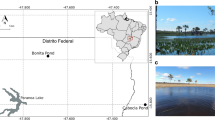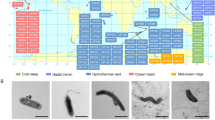Abstract
Microbial community structures in the Arctic deep-sea sedimentary ecosystem are determined by organic matter input, energy availability, and other environmental factors. However, global warming and earlier ice-cover melting are affecting the microbial diversity. To characterize the Arctic deep-sea sediment microbial diversity and its relationship with environmental factors, we applied Roche 454 sequencing of 16S rDNA amplicons from Arctic deep-sea sediment sample. Both bacterial and archaeal communities’ richness, compositions and structures as well as taxonomic and phylogenetic affiliations of identified clades were characterized. Phylotypes relating to sulfur reduction and chemoorganotrophic lifestyle are major groups in the bacterial groups; while the archaeal community is dominated by phylotypes most closely related to the ammonia-oxidizing Thaumarchaeota (96.66%) and methanogenic Euryarchaeota (3.21%). This study describes the microbial diversity in the Arctic deep marine sediment (>3 500 m) near the North Pole and would lay foundation for future functional analysis on microbial metabolic processes and pathways predictions in similar environments.
Similar content being viewed by others
References
Aller J Y, Kemp P F. 2008. Are Archaea inherently less diverse than Bacteria in the same environments? FEMS Microbiology Ecology, 65(1): 74–87
Arnosti C. 2008. Functional differences between Arctic seawater and sedimentary microbial communities: contrasts in microbial hydrolysis of complex substrates. FEMS Microbiology Ecology, 66(2): 343–351
Auguet J C, Barberan A, Casamayor E O. 2009. Global ecological patterns in uncultured Archaea. The ISME Journal, 4(2): 182–190
Bano N, Ruffin S, Ransom B, et al. 2004. Phylogenetic composition of Arctic Ocean archaeal assemblages and comparison with Antarctic assemblages. Applied and Environmental Microbiology, 70(2): 781–789
Bland J, Brock T D. 1973. The marine bacterium Leucothrix mucor as an algal epiphyte. Marine Biology, 23(4): 283–292
Boetius A, Albrecht S, Bakker K, et al. 2013. Export of algal biomass from the melting Arctic Sea ice. Science, 339(6126): 1430–1432
Boetius A, Damm E. 1998. Benthic oxygen uptake, hydrolytic potentials and microbial biomass at the Arctic continental slope. Deep-Sea Research Part I: Oceanographic Research Papers, 45(2–3): 239–275
Bowman JP, McCuaig RD. 2003. Biodiversity, community structural shifts, and biogeography of prokaryotes within Antarctic continental shelf sediment. Applied and Environmental Microbiology, 69(5): 2463–2483
Bowman J S, Rasmussen S, Blom N, et al. 2011. Microbial community structure of Arctic multiyear sea ice and surface seawater by 454 sequencing of the 16S RNA gene. The ISME Journal, 6(1):11–20
Clarke A. 2003. The polar deep seas. In: Ecosystems of the World. The Netherlands: Elsevier Science, 239–260
Cottrell M T, Kirchman D L. 2000. Natural assemblages of marine proteobacteria and members of the Cytophaga-Flavobacter cluster consuming low-and high-molecular-weight dissolved organic matter. Applied and Environmental Microbiology, 66(4): 1692–1697
Deming J W. 1986. Ecological strategies of barophilic bacteria in the deep ocean. Microbiological Sciences, 3(7): 205–211
Fahl K, Stein R. 1997. Modern organic carbon deposition in the Laptev Sea and the adjacent continental slope: surface water productivity vs. terrigenous input. Organic Geochemistry, 26(5–6): 379–390
Forschner S R, Sheffer R, Rowley D C, et al. 2009. Microbial diversity in Cenozoic sediments recovered from the Lomonosov Ridge in the Central Arctic Basin. Environmental Microbiology, 11(3): 630–639
Galand P E, Casamayor E O, Kirchman D L, et al. 2009. Unique archaeal assemblages in the Arctic Ocean unveiled by massively parallel tag sequencing. The ISME Journal, 3(7): 860–869
Gooday A J, Turley C M, Allen J A. 1990. Responses by benthic organisms to inputs of organic material to the ocean floor: a review. Philosophical Transactions of the Royal Society of London Series A, Mathematical and Physical Sciences, 331(1616): 119–138
Gosselin M, Levasseur M, Wheeler P A, et al. 1997. New measurements of phytoplankton and ice algal production in the Arctic Ocean. Deep-Sea Research Part II: Topical Studies in Oceanography, 44(8): 1623–1644
Hinzman L D, Bettez N D, Bolton W R, et al. 2005. Evidence and implications of recent climate change in northern Alaska and other arctic regions. Climatic Change, 72(3): 251–298
Huson D H, Mitra S, Ruscheweyh H J, et al. 2011. Integrative analysis of environmental sequences using MEGAN4. Genome Research, 21(9): 1552–1560
Jacob M, Soltwedel T, Boetius A, et al. 2013. Biogeography of deep-sea benthic bacteria at regional scale (LTER HAUSGARTEN, Fram Strait, Arctic). PLoS One, 8(9): e72779
Jannasch H W, Taylor C D. 1984. Deep-sea microbiology. Annual Review of Microbiology, 38(1): 487–487
Jørgensen B B. 1982. Mineralization of organic matter in the sea bed—the role of sulphate reduction. Nature, 296(5858): 643–645
Kasai Y, Kishira H, Sasaki T, et al. 2002. Predominant growth of Alcanivorax strains in oil-contaminated and nutrient-supplemented sea water. Environmental Microbiology, 4(3): 141–147
Kirchman D L. 2002. The ecology of Cytophaga-Flavobacteria in aquatic environments. FEMS Microbiology Ecology, 39(2): 91–100
Kirchman D L, Morán X A G, Ducklow H. 2009. Microbial growth in the polar oceans—role of temperature and potential impact of climate change. Nature Reviews Microbiology, 7(6): 451–459
Luo Haiwei. 2012. Predicted protein subcellular localization in dominant surface ocean bacterioplankton. Applied and Environmental Microbiology, 78(18): 6550–6557
Macdonald R W, Solomon S M, Cranston R E, et al. 1998. A sediment and organic carbon budget for the Canadian Beaufort Shelf. Marine Geology, 144(4): 255–273
Methé B A, Nelson K E, Deming J W, et al. 2005. The psychrophilic lifestyle as revealed by the genome sequence of Colwellia psychrerythraea 34H through genomic and proteomic analyses. Procee-dings of the National Academy of Sciences of the United States of America, 102(31): 10913–10918
Mori K, Iino T, Suzuki K I, et al. 2012. Aceticlastic and NaCl-requiring methanogen “Methanosaeta pelagica” sp. nov., isolated from marine tidal flat sediment. Applied and Environmental Microbiology, 78(9): 3416–3423
Nedashkovskaya O I, Kim S B, Han S K, et al. 2004. Maribacter gen. nov., a new member of the family Flavobacteriaceae, isolated from marine habitats, containing the species Maribacter sedimenticola sp. nov., Maribacter aquivivus sp. nov., Maribacter orientalis sp. nov. and Maribacter ulvicola sp. nov. International Journal of Systematic and Evolutionary Microbiology, 54(Pt4): 1017–1023
Perdue E M, Koprivnjak J F. 2007. Using the C/N ratio to estimate terrigenous inputs of organic matter to aquatic environments. Estuarine, Coastal and Shelf Science, 73: 65–72
Pester M, Schleper C, Wagner M. 2011. The Thaumarchaeota: an emerging view of their phylogeny and ecophysiology. Current Opinion in Microbiology, 14(3): 300–306
Peterson B J, Holmes R M, McClelland J W, et al. 2002. Increasing river discharge to the Arctic Ocean. Science, 298(5601): 2171–2173
Price M N, Dehal P S, Arkin A P, et al. 2010. FastTree—approximately maximum-likelihood trees for large alignments. PloS One, 5(3): 9490
Pruesse E, Quast C, Knittel K, et al. 2007. SILVA: a comprehensive online resource for quality checked and aligned ribosomal RNA sequence data compatible with ARB. Nucleic Acids Research, 35(21): 7188–7196
Quast C, Pruesse E, Yilmaz P, et al. 2013. The SILVA ribosomal RNA gene database project: improved data processing and web-based tools. Nucleic Acids Research, 41(D1): 590–596
R Core Team. 2014. R: A Language and Environment for Statistical Computing. Vienna, Austria: R Foundation for Statistical Computing
Rappe M S, Kemp P F, Giovannoni SJ. 1997. Phylogenetic diversity of marine coastal picoplankton 16S rRNA genes cloned from the continental shelf off Cape Hatteras, North Carolina. Limnology and Oceanography, 42(5): 811–826
Ravenschlag K, Sahm K, Amann R. 2001. Quantitative molecular analysis of the microbial community in marine Arctic sediments (Svalbard). Applied and Environmental Microbiology, 67(1): 387–395
Ravenschlag K, Sahm K, Pernthaler J, et al. 1999. High bacterial diversity in permanently cold marine sediments. Applied and Environ-mental Microbiology, 65(9): 3982–3989
Sahm K, Berninger UG. 1998. Abundance, vertical distribution, and community structure of benthic prokaryotes from permanently cold marine sediments (Svalbard, Arctic Ocean). Marine Ecology Progress Series, 165: 71–80
Sahm K, Knoblauch C, Amann R. 1999. Phylogenetic affiliation and quantification of psychrophilic sulfate-reducing isolates in marine arctic sediments. Applied and Environmental Microbiology, 65(9): 3976–3981
Schloss P D, Westcott S L, Ryabin T, et al. 2009. Introducing mothur: open-source, platform-independent, community-supported soft-ware for describing and comparing microbial communities. Applied and Environmental Microbiology, 75(23): 7537–7541
Smith K S, Ingram-Smith C. 2007. Methanosaeta, the forgotten methanogen? Trends in Microbiology, 15(4): 150–155
Stein R, Grobe H, Wahsner M. 1994. Organic carbon, carbonate, and clay mineral distributions in eastern central Arctic Ocean surface sediments. Marine Geology, 119(3–4): 269–285
Stein R, MacDonald R W. 2004. The Organic Carbon Cycle in the Arctic Ocean. Berlin: Springer Verlag
Suzuki M T, Rappe M S, Haimberger Z W, et al. 1997. Bacterial diversity among small-subunit rRNA gene clones and cellular isolates from the same seawater sample. Applied and Environmental Microbiology, 63(3): 983–989
Teske A, Durbin A, Ziervogel K, et al. 2011. Microbial community com-position and function in permanently cold seawater and sediments from an Arctic fjord of Svalbard. Applied and Environmental Microbiology, 77(6): 2008–2018
Thomas D N, Lara R J, Eicken H, et al. 1995. Dissolved organic matter in Arctic multi-year sea ice during winter: major components and relationship to ice characteristics. Polar Biology, 15(7): 477–483
Tian Fei, Yu Yong, Chen Bo, et al. 2009. Bacterial, archaeal and eukaryotic diversity in Arctic sediment as revealed by 16S rRNA and 18S rRNA gene clone libraries analysis. Polar Biology, 32(1): 93–103
Wagner-Döbler I, Biebl H. 2006. Environmental biology of the marine Roseobacter lineage. Annu Rev Microbiol, 60(1): 255–280
Wang Yan, Yu Min, Austin B, et al. 2012. Oleispira lenta sp. nov., a novel marine bacterium isolated from Yellow sea coastal seawater in Qingdao, China. Antonie van Leeuwenhoek, 101(4): 787–794
Wheeler P A, Gosselin M, Sherr E, et al. 1996. Active cycling of organic carbon in the central Arctic Ocean. Nature, 380(6576): 697–699
Zeng Yinxin, Zou Yang, Chen Bo, et al. 2011. Phylogenetic diversity of sediment bacteria in the northern Bering Sea. Polar Biology, 34(6): 907–991
Author information
Authors and Affiliations
Corresponding author
Additional information
Foundation item: The National Natural Science Foundation of China under contract No. 41121064; the NSFC-Shandong Joint Fund for Marine Science Research Centers under contract No. U1406403; the Science Foundation for Post Doctorate Research from the Chinese Academy of Sciences under contract No. 2012M511072.
Rights and permissions
About this article
Cite this article
Li, Y., Liu, Q., Li, C. et al. Bacterial and archaeal community structures in the Arctic deep-sea sediment. Acta Oceanol. Sin. 34, 93–113 (2015). https://doi.org/10.1007/s13131-015-0624-9
Received:
Accepted:
Published:
Issue Date:
DOI: https://doi.org/10.1007/s13131-015-0624-9




